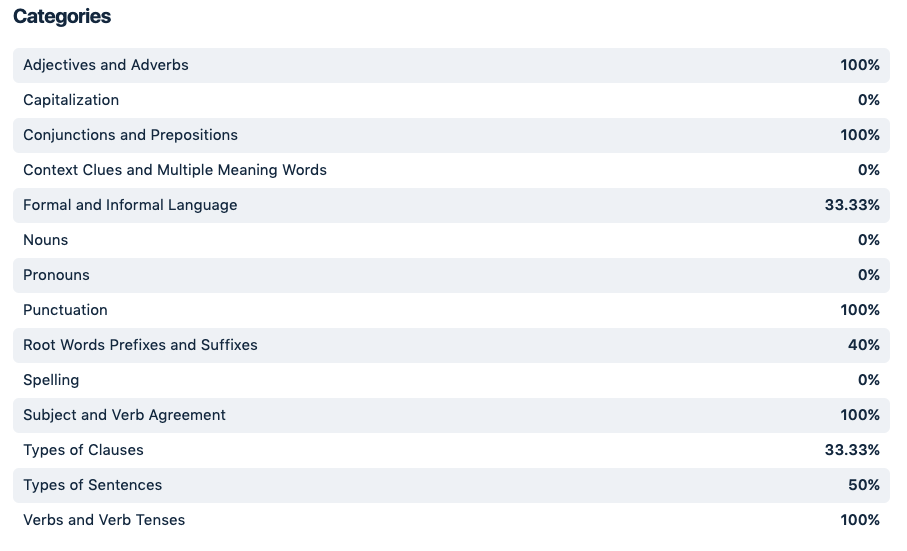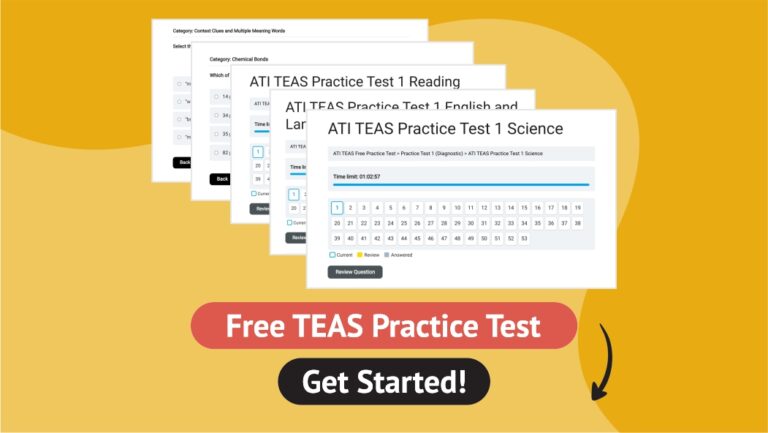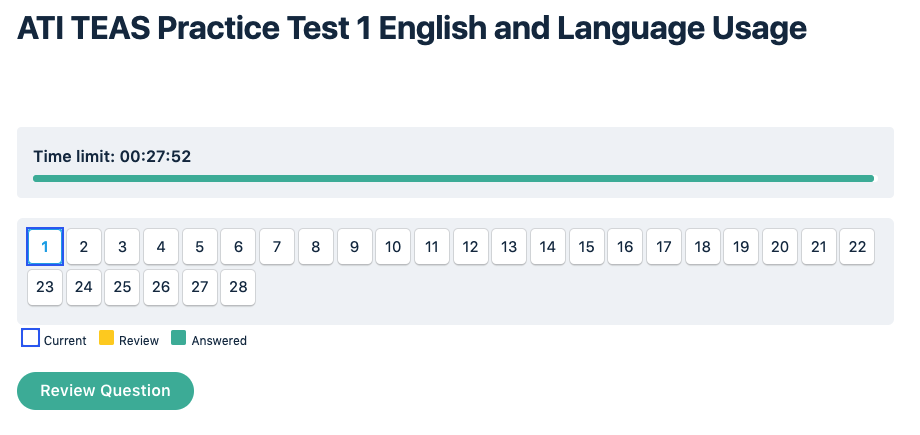How To Study For The English Section Of The ATI TEAS Test
In this post we’ll go over an outline of all the topics you will see on the English section of the ATI TEAS exam as well as provide you with a free timed English TEAS practice test. This outline comes directly from the Smart Edition Academy TEAS online course, so you’ll also get an idea of how using a timed TEAS English practice test can help you become more comfortable with the format of the test, the types of questions you will see, and help you become faster at answering the questions with the given time limit. Check out everything you need to know about the test in our TEAS test ultimate guide review.
So how do you study for the English and Language Usage section of the ATI TEAS test? We get this question all the time. You’re not the first person to ask and you’re not the first person to struggle with this section of the ATI TEAS test.
Step 1: If you’re *just starting* or taking the TEAS for another attempt, the first thing to do is take a free timed English TEAS practice test here.
By taking this English TEAS practice test, you have access to a full-length timed practice test which will then give you a breakdown of how you did on all the topics outlined in the table of contents below. As a result you’ll also get a “feel” for how quickly the time passes so you can be prepared for the actual test.
Step 2: Evaluate your diagnostic report from the ATI TEAS English practice test section of the practice test. Most importantly notate exactly what topics within English you did well on and the areas you need more practice on.

Step 3: Make a study schedule or a study plan. For example begin by making a list of subjects within the English section that you are scoring 70% or better, 40-69%, and 0-39%.
Likewise, Don’t study topics that you scored high in. Start by studying the topics you scored the lowest in because you will have to revisit those topics several times and apply practice before seeing improvements in those categories.
Study the topics you scored low in and begin to plan when you will study these topics.
For example, for two weeks straight, you might dedicate 6 hours a week to reviewing a few categories within the English section: verbs, verb tenses, adjectives, and adverbs.
Watch this video on how to make a TEAS study schedule with a free template here.
Step 4: Get Good TEAS Test Prep Resources Based On Your Learning Style
If you like to study within a group, you might like our free group tutoring sessions and Facebook study group.
If you like to study by listening or watching videos, you’ll love the 100+ videos in our 50+ lessons inside of our ATI TEAS Online Course.
If you like to take practice tests and study from the answer explanations, you’ll love our 1,300+ practice questions and 8 timed practice tests in the ATI TEAS Online Course.
Step 5: Retake a TEAS English and Language Usage practice test here. At the end of those two weeks, you should be able to retake the practice test and see progression in 4 of the categories you’ve been studying.
Above all we recommend taking a practice test every 10-14 days to track your improvement. Students say studying for 6-10 weeks gives them the ability to take 4-6 practice tests and plenty of time to tackle their weak areas within each section.
ATI TEAS Test English Practice Test and Review
Many students have a hard time with the English and Language Usage section of the ATI TEAS test. It can be particularly challenging if English is your second language.
The good news is that English is based on a lot of rules, so if you can master a lot of these rules it becomes a bit more black and white rather than something that is open for interpretation like the reading section of the TEAS test.
The other good bit of news is that all of the English topics on the test are things that were taught in high school, so you will just be revisiting those topics again and hopefully not for the first time.
The English section of the ATI TEAS test has 28 questions in 28 minutes.
Don’t let the smaller number of questions fool you, that is to say just because it has fewer questions and a shorter amount of time than the other sections doesn’t make it easier.
The challenge is if you answer more of the questions wrong, because you have a smaller number, it actually brings your score down pretty quickly, as opposed to say science, where you have 53 questions and if you answer a few wrong, it doesn’t bring your score down as much.
If you drop five of the English questions with incorrect answers, that’s going to have more of an impact. As a result you should take this section pretty seriously, because just for that reason you don’t want to lower your score unnecessarily.
Conventions of Standard English TEAS Test
Spelling
Spelling correctly is important to accurately convey thoughts to an audience. Our ATI TEAS online course lesson for this topic will cover:
- Vowels and consonants
- Suffixes and plurals
- Homophones and homographs
You’ll need to know your vowels AEIOU and all of the consonants which is everything besides the vowels.
Know your rules like I before E except after C, changing that final Y to an I. These are some of the rules that are going to help you.
Remember, homophones sound the same, but have a different meaning and homographs are spelled the same, but have a different meaning. So know those differences and kind of why they’re different.
Don’t get tripped up on questions about commonly misspelled words. There is a good chance you’re going to see some questions like this on the test.
Understand commonly missppelled words ← see what we did there?!?! lol… words like:
- Accommodate
- Embarrass
- Scissors
One thing that you can do is identify some of the ones that you always get wrong, get a list of those words and just spell them out over and over and over again, and drill it into your head how they are spelled.
After doing that, when you see one of those words on the test, you’re going to know how to spell it correctly.
Capitalization
- Geographic locations and event names
- Organizations and publication titles
- Individual names and professional titles
- Months, days, and holidays
- Organizations
- Public titles
- Individual names
- Professional names
- Months
- Days
- Holidays
Punctuation
Punctuation is important in writing to accurately represent ideas. Without correct punctuation, the meaning of a sentence is difficult to understand. The ATI TEAS online course lesson for this topic will cover:
- Periods, question marks, and exclamation points
- Commas, semicolons, and colons
- Apostrophes, hyphens, and quotation marks
In addition you will need to know what’s called terminal punctuation, this is the ending punctuations:
- Periods
- Question marks
- Exclamation points
Know what is the appropriate punctuation choice and when to use them and when to not.
Next up you’ll need to know internal punctuation:
- Commas
- Colons
- Semi-colons
- Apostrophes
- Hyphens
- Quotation Marks
There are a lot of rules for grammatically correct English, just know and follow the rules and you should be okay.
For example a question you might see is something like a sentence with a blank space and it asks which of the following correctly completes the sentence.
So you need to know those eight parts of speech and punctuation.
Similarly you you might have two sentences and it’ll say:
“choose the correct punctuation to complete this sentence” and the answer maybe needs to be a semi-colon, but it’ll throw things at you like a conjunction as an answer option to try and trick you, but you need know that semi-colons, can’t be used as conjunctions.
So again, it’s just kind of knowing a lot of these rules and if you know them well, you’ll be okay with this topic.
TEAS Test Parts of Speech
Nouns
You will need to learn about nouns. A noun is a word that names a person, place, thing, or idea. The Smart Edition Academy ATI TEAS online course lesson for this topic will cover:
- The role of nouns in sentences
- Different types of nouns
You need to know your nouns, how they’re used in sentences, and the different types of nouns:
- Singular
- Plural
- Common
- Proper
- Concrete
- Abstract
Pronouns
A pronoun is a word that takes the place of or refers to a specific noun. The Smart Edition Academy ATI TEAS online course lesson for this topic will cover:
- The role of pronouns in sentences
- The purpose of pronouns
There’s a couple of different types of pronouns and you need to know how they’re used in sentences:
- Subject
- Object
- Possessive pronouns
- Relative pronouns
Adjectives and Adverbs
An adjective describes, modifies, or tells us more about a noun or a pronoun.
An adverb describes, modifies, or tells us more about a verb, an adjective, or another adverb.
Be familiar with adjectives as well as articles like a, an, the.
Conjunctions and Prepositions
A conjunction connects words, phrases, or clauses. And, so, and or are conjunctions. A preposition is a relationship word; it shows the relationship between two nearby words.
You should become familiar with the different types of conjunctions:
- Coordinating
- Subordinating
- Correlative
In addition you should be familiar with prepositions which show the relationship between two nearby words as well as prepositional phrases.
Verbs and Verb Tenses
A verb is a word that describes a physical or mental action or a state of being. The Smart Edition ATI TEAS online course lesson for this topic will cover:
- The role of verbs in sentences
- Verb forms and tenses, and helping verbs
First you’ll need to know the verb forms
- Base form
- Past form
- Participle form
Another type of verb to know is the helping verb:
- to have
- to do
Verb tenses for the present, past, and future:
- Present perfect
- Past perfect
- Future perfect
Knowledge of Language TEAS Test
Subject and Verb Agreement
Every sentence must include a subject and a verb. The subject tells who or what, and the verb describes an action or condition.
Here is what’s important to know about subject and verb agreement:
- Every sentence has a subject and a verb. The predicate is the part of the sentence that contains the verb.
- The subject and verb must agree in number and person.
- The third person singular subject takes a different verb form
Types of Sentences
Sentences are a combination of words that communicate a complete thought. Sentences can be written in many ways to signal different relationships among ideas. The Smart Edition ATI TEAS online course lesson for this topic will cover:
- Simple sentence
- Compound sentence
- Complex sentence
- Parallel structure
Types of Clauses
There are four types of clauses that are used to create sentences. Sentences with several clauses, and different types of clauses, are considered complex. The Smart Edition Academy ATI TEAS online course lesson will cover:
- Independent clause
- Dependent and subordinate clause
- Coordinate clause
You will need to know which clause is being used in a sentence and how each one should be used.
Formal and informal language
In English, there is formal language that is used most often in writing, and informal language that is most often used in speaking, but there are situations where one is more appropriate than the other.
The Smart Edition ATI TEAS online course lesson for this topic will cover differentiating contexts for:
- Formal language
- Informal language
You will need to know The Difference Between Formal and Informal Language
- Formal language is used in professional and academic writing and talks. It does not have contractions, uses complete sentences, uses polite and formal vocabulary, not slang, and is not personal and does not use the pronouns “I” and “We” as the subject of a sentence.
- Informal language is used in daily life when communicating with friends and family through conversations, text messages, emails, letters, and postcards. It uses contractions, can be sentence fragments, uses less formal vocabulary and slang, and is personal and uses pronouns such as “I” and “We” as the subject of a sentence.
Vocabulary Acquisition TEAS Test
Root Words, Prefixes, and Suffixes
A root word is the most basic part of a word. You can create new words by: adding a prefix, a group of letters placed before the root word; or a suffix, a group of letters placed at the end of a root word.
In TEAS online course this lesson reviews: root words prefixes, suffixes and how to determine the meaning of a word by analyzing these word parts.
You should be able to determine the meaning of a word based on either the root word, prefix or suffix.
Context Clues and Multiple Meaning Words
Sometimes when you read a text, you come across an unfamiliar word. Instead of skipping the word and reading on, it is important to figure out what that word means so you can better understand the text.
There are different strategies you can use to determine the meaning of unfamiliar words.
The Smart Edition Academy ATI TEAS online course lesson for this topic will cover:
- How to determine unfamiliar words by reading context clues,
- Multiple meaning words
- Using multiple meaning words properly in context
Multiple meaning words are things like:
Season which could be a time of year or it could be to spice or add seasoning to food.
Current could be a current on a river, or an electrical current.
You need to know within the context of what you’re reading and how the word is being used what the meaning of that word is.
Conclusion
While the English section of the test contains a lot of material and a lot of rules to know, if you are able to put in the study time with good study materials you should be able to dominate this section.
Take advantage of our free TEAS practice tests and ATI TEAS online course in order to get the most out of your study time.


